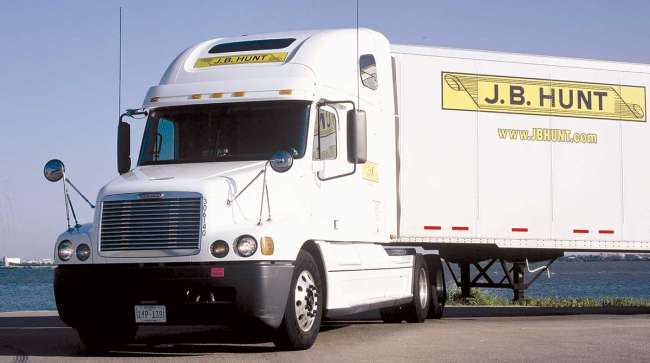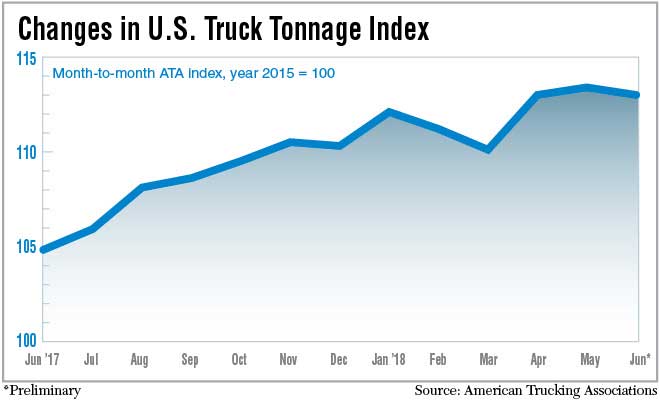Tonnage Rises 7.8% in June, Up 8% in First Half of 2018

Truck tonnage continued its powerful run in June, rising 7.8% compared with year-ago levels and up nearly 8% through the first half of 2018, according to American Trucking Associations’ advanced seasonally adjusted for-hire Truck Tonnage Index.
The index equaled 113.0 in June, down from 113.4 in May. The index value for May was revised to an increase of 0.4%, down from its originally reported 0.7% rise.
Through the first half of 2018, tonnage has increased 7.9%, more than doubling the 3.8% gain seen in the first of 2017, ATA reported.

Costello
“In the second quarter, we saw the tonnage index jump 1.8% from the previous quarter and 8.4% from a year earlier,” ATA Chief Economist Bob Costello said. “This robust growth fits with what is likely to be a very strong GDP reading for the second quarter. I expect the growth in tonnage to moderate, but remain at very high levels in the months ahead.”
ATA’s not-seasonally adjusted index, representing the change in tonnage actually hauled by fleets before any seasonal adjustment, was valued at 116.3 in June, a decline of 1.1% from the 117.6 value for the previous month.
Trucking accounts for 70.6% of tonnage carried by all modes of domestic freight transportation, effectively serving as a barometer of the U.S. economy. ATA calculates the tonnage index based on surveys of its membership. The figures for June are preliminary and subject to revision.
Industry analysts report their data also showed a very active summer for trucking.
Spot rates rose in June due to the need for trucks but the first half of July was equally strong, said Peggy Dorf, market analyst at load board operator DAT Solutions.
“July is proving to be a hot month though it is typically slower,” Dorf said. “June was a record high at $2.31 per mile for average van rates nationwide and July may surpass that. Manufacturers and other sectors need trucks because e-commerce promotions in July keep more freight in the pipeline.”
For instance, more than 100 million products were purchased during Amazon Prime Day, the mid-July, 36-hour shopping spree hosted by the e-commerce behemoth.
E-commerce also has spurred the freight industry to develop a network of depots near to consumers so product can be delivered in a day or two, Dorf said.

Dorf
“There’s the trend towards bringing goods closer to the final destination, with more products moved in advance to get closer,” Dorf said.
The next few months look like they will stay busy as back-to-school sales kick in, Dorf noted.
Another firm that measures freight activity reported that June demand was “exceeding capacity in most modes of transportation by a significant margin.” The Cass Freight Index Report found that “the current level of volume and pricing growth is signaling that the U.S. economy is growing, but that level of growth may have reached its short-term expansion limit.”
Cass tracks monthly levels of shipment activity through two indexes, the volume of shipments and expenditures for freight shipments. It is based on the shipments by Cass clients from a range of industries. The expenditures index in June grew nearly 16% from a year ago.
The Cass Shipments Index in June grew 7.2% year-over-year, though that is down from “the extraordinary 10%+ pace established in the January through May period.”
Tom Bertolino, Cass director of product development who oversees the indexes, cautioned that shippers are seeing their costs rise and that leads to inflation.
That’s a sign the economy is on track to a correction, Bertolino said.

“The current cycle is fueled by tax reform and other stimulants that drive transportation costs up,” Bertolino said. “But the Federal Reserve’s mission is to control inflation. At some point the party will end. We don’t know if it will be ugly and sudden. This increase is unsustainable. “
Most broad economic indicators are indicating continued growth.
The Institute for Supply Management reported its manufacturing index at 60.2% in June, up 1.5 percentage points from May, as 17 out of 18 manufacturing industries reported growth. An index value greater than 50% shows expansion. The institute said it was the 110th consecutive month of growth for the overall economy.
The Federal Reserve Industrial Production Index moved up 0.6% in June to 107.7. The index rose 3.8% from June 2017 to June 2018. Manufacturing output increased at an annual rate of 1.9% in the second quarter, about the same pace as in the first quarter.
Housing is facing headwinds. For June the Census Bureau showed 1,173,000 housing starts on an annualized basis, down 4.2% from June 2017, and down 12.3% from a revised May estimate.
Retail sales reached $506.8 billion in June, a 6.6% jump from June 2017. Total sales for the second quarter rose 5.9% from the same period a year ago.




